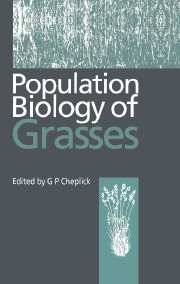Book contents
- Frontmatter
- Contents
- Contributors
- Preface
- Darwin revisited: approaches to the ecological study of grasses
- Part one Population variation and life history patterns
- 1 Allozyme diversity in the grasses
- 2 Ecology of seed dormancy and germination in grasses
- 3 Seed dispersal and seedling establishment in grass populations
- 4 Clonal biology of caespitose grasses
- 5 Ecological aspects of sex expression in grasses
- 6 Interspecific variation in plasticity of grasses in response to nitrogen supply
- 7 Population biology of intraspecific polyploidy in grasses
- Part two Ecological interactions
- Part three Population biology of specific groups
- Index
3 - Seed dispersal and seedling establishment in grass populations
Published online by Cambridge University Press: 14 September 2009
- Frontmatter
- Contents
- Contributors
- Preface
- Darwin revisited: approaches to the ecological study of grasses
- Part one Population variation and life history patterns
- 1 Allozyme diversity in the grasses
- 2 Ecology of seed dormancy and germination in grasses
- 3 Seed dispersal and seedling establishment in grass populations
- 4 Clonal biology of caespitose grasses
- 5 Ecological aspects of sex expression in grasses
- 6 Interspecific variation in plasticity of grasses in response to nitrogen supply
- 7 Population biology of intraspecific polyploidy in grasses
- Part two Ecological interactions
- Part three Population biology of specific groups
- Index
Summary
Whether as native components of a regional flora or as weedy invaders in agricultural fields, their widespread distribution on Earth implies that grasses are successful in the colonization of a diversity of habitats. Critical to this success are various forms of asexual reproduction such as clonality or apomixis (Clark & Fisher, 1987; Chapman, 1992). In addition, many grasses possess morphological modifications of sexual reproductive structures that enhance the dispersal of caryopses (Davidse, 1987; Clayton, 1990) or promote successful seedling establishment (Peart, 1979, 1981). In his classic book The Dispersal of Plants Throughout the World, Ridley (1930) stated that the common reed grass Phragmites communis was ‘the most widely distributed species of all flowering plants in the world’ and noted that it was one of the first grasses to reach Krakatau after the island's vegetation had been destroyed by a volcano. He attributed the species' success to its adaptation for dispersal by wind, claiming that ‘the spikelets can evidently fly 25 miles [40 km] without falling.’
Additional anecdotal evidence for the long-distance transport of grasses based on geographical patterns of distribution including islands can be found in many other examples provided by Ridley (1930) and van der Pijl (1982). However, such long-distance dispersal is likely to be rare and dependent on catastrophic events like severe tropical storms. This review will focus on processes occurring at the scale of the population and it will be shown that the usual dispersal potential for members of the grass family actually may be quite modest.
Davidse (1987) provided a systematic overview of the characteristic features of spikelets and infloresences adapted to a diversity of dispersal agents, using examples mostly from three tribes of the Poaceae.
- Type
- Chapter
- Information
- Population Biology of Grasses , pp. 84 - 105Publisher: Cambridge University PressPrint publication year: 1998
- 27
- Cited by



